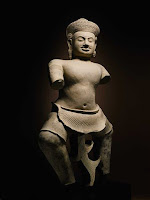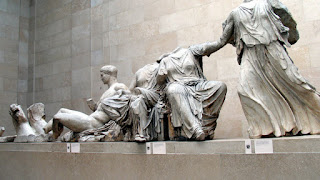Now apply the same idea to countries. The last time the domino effect was seriously invoked, it was in the form of a threat. American politicians and senior military officers used it to justify a hardline approach in Indochina against the “communist threat.” If one country “went” communist, the rest would fall. Here, the domino was South Vietnam. The other tiles were Laos and Cambodia, and then, who knows? Thailand? India? The “domino effect” was an integral component of the Cold War.
 |
| The domino theory in Southeast Asia |
Let’s now turn our attention to the museum world. In order for the domino effect to work in the museum world, one needs a critical mass of cultural institutions predisposed to lean in one direction or another. In our case, the domino unit is “restitution”, the “return” of looted cultural assets to rightful owners, be they individuals, communities, tribes or source nations. For there to be a domino effect in the museum world, there needs to be a restitution, a repatriation which “tips the scales” in a way that paves the way for similar returns by other institutions and provokes a generalized onrush of claims that will ultimately provoke more returns, more repatriations, instability in the management of collections, loss of equilibrium in negotiations of loans with source nations, impending chaos, the end of the world as we know it.
Believe it or not, museum leaders and nations whose cultural institutions harbor looted cultural property have invoked the “domino effect” either to prevent restitutions or to isolate restitutions as unique cases which cannot be repeated, fearing that, if such restrictions are not imposed in a settlement, more claims will be filed and a generalized disgorgement of looted objects would ensue in favor of the aggrieved nations. As you know, that simply cannot happen.
 |
| The Wrestler from Koh Ker |
The repatriation of the Koh Ker statues to Cambodia, it is argued, triggered a minor “domino effect” or a “breaking of the dam.” After Cambodia had won its case against Sotheby’s in December 2013, the matter could have been isolated to that one return. But there were many more statues located in different cultural institutions throughout the United States. The Metropolitan Museum of Art followed suit and agreed to return its two statues, followed by a return from Christie’s and the Norton Simon Museum in Pasadena, CA. So did the Cleveland Museum of Art.
 |
| Parthenon Marbles on view at the British Museum, London |
An unusual twist to the repatriation/domino effect dyad refers to the hypothetical “devolution” of Wales and Scotland which might provoke a deluge of repatriation requests against “English” museums that would gut them of significant numbers of objects. Hence, in a twist of irony, the threat of falling dominos may not come from those “nationalist” source nations which selfishly demand their looted property back, but rather from insurgent regionalist movements plaguing the halls of power in London. How fitting!
So, what’s all the hullaballoo about with all of these dominos falling and the world of museums as we know it collapsing around us because of incessant claims for return of looted cultural property to source nations and tribal communities?
In true fashion, France embodies the worst of the anti-restitution movement, whereby objects, as a rule, do not leave State-controlled museums under any circumstances. Once in, there is no conceivable exit. The principle of inviolability reigns over the management of cultural objects in French museums, regardless of provenance and origin.
In the case of the Oekyujanggak Royal Manuscripts which South Korea claimed, the French government rejected the Korean repatriation claim. Granted, the case was complicated. The French navy had stolen these sacred royal documents in 1866 presumably in retaliation for the deaths of nine Catholic priests. [This bears strange similarities to the punitive confiscation of bronzes in Benin in 1897 as a retaliatory act by British colonial troops].
These manuscripts were rediscovered in 1975 at the “Bibliothèque nationale” in Paris.
 |
| Sample pages from the Oekyujanggak Manuscripts |
The idea of recovering these manuscripts first was discussed in 1991 by scholars at Seoul National University. South Korea filed a formal request for restitution in 1993. The claim quickly became entangled in larger trade issues between South Korea and France involving high-speed train contracts. [A similar entanglement occurred in the United States which linked high-speed train contracts between France and the United States to pending Holocaust-era claims against French railroads.] The discussion between the two nations evolved into a possible exchange through loans of artifacts of equal worth between the two nations.
Regardless of what law applied, France invoked the “domino theory” and felt that an unconditional return of the royal manuscripts without any “contrepartie” from South Korea might provoke a generalized gutting of colonial-era plunder from French institutions.
In Korea, opposition built up and voiced against a proposed exchange of similar documents with Fraance, because, the argument went, any exchange or loan would be tantamount to a recognition of the plunderer’s right to good title, enabling nations like France to loot another nation’s treasures and get away with it.
In February 2011, an agreement was signed between France and South Korea outlining the terms under which the royal manuscripts could return to the Korean people. It wasn’t so much a return as a long-term loan renewable every five years. Hence, title remained with the French government while South Korea obtained the equivalent of “custodial rights” over their stolen royal manuscripts.
Furthermore, the French government insisted in Article 4 of the 2011 agreement that:
“The loan of the Uigwe manuscripts by France to Korea is a transaction characterized by its uniqueness, which cannot be replicated under any circumstance and cannot be viewed as setting a precedent…”
In other words, France would never repeat this folly again.
 |
| A scarecrow |